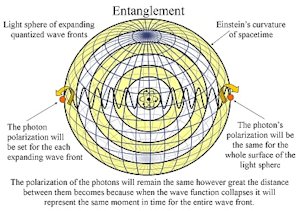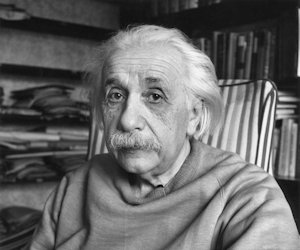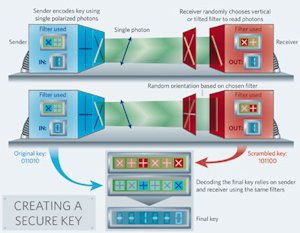Quantum Mechanics 101: Entanglement
 | | Couldn't be simpler |
In a proposal today in the Institute of Physics and German Physical Society's New Journal of Physics, physicist Rupert Ursin of the Australian Academy of Sciences, along with colleagues, suggests sending half of an entagled pair of particles to the International Space Station in order to test quantum entanglement at a distance of roughly 400 kilometers. This would be the greatest distance at which quantum entanglement has been practically tested, and could thus provide some insights into how it works. This may not sound important, but it is, because the nature of quantum entanglement remains one of the greatest enduring mysteries of science. In order to grasp why we should pay attention to proposals like Ursin's (and why people should support them), let's take a step back and look at the history of the entanglement conundrum.
As he approached the end of his life, Albert Einstein struggled to come up with a Grand Unified Theory of Physics that would sufficiently describe the physical universe and the forces that control it. His biggest stumbling block was quantum mechanics, a new branch of theoretical physics at the time which postulates that, at the smallest of scales, the physical universe is ruled over by probability and indeterminacy. For Einstein, the idea that there were things in nature that could never be measured, known, or precisely predicted was pseudoscientific nonsense that went against the core precepts of science as he understood it. To illustrate this point, he and two of his collegues, Boris Podolsky and Nathan Rosen, created an infamous thought experiment that he hoped would debunk one of the central tenants of quantum mechanics.
 | | Einstein: victim of Clarke's First Law |
According to Einstein's relativity theories, absolutely nothing can move faster than light. As Einstein understood things, this is a fundamental law built into the geometry of the universe, meaning you could no easier exceed the speed of light than a circle could have corners. However, Einstein, Podolsky, and Rosen thought they had uncovered, within the basics of quantum mechanics, a way to break this fundamental law, which would invalidate the discipline of quantum mechanics altogether, or at least require some serious refinement in order to bring it into a relativistic framework.
The thought experiment (known as the EPR paradox) goes something like this: (1) Quantum indeterminacy states that subatomic particles have pairs of physical qualities such as position and momentum, and that if you accurately measure one of these qualities, the counterpart quality will become indeterminate (thus, you can not know both the specific position and specific momentum of any given particle); (2) Two particles can be "entagled" such that they are complementary on a quantum level, so that the measurement of one particle will affect the quantum state of the other; (3) Quantum information between entagled particles would have to be instantaneous, meaning that the information would have to move faster than the speed of light.
 | | The transistor radio would be impossible without quantum mechanics |
This "spooky action at a distance," as far as Einstein was concerned, should have been the end of the debate. If quantum information cannot travel faster than light, as relativity supposes, and if it can be proved that entagled particles share quantum traits simultaneously (as has subsequently been proven many times), the act of measuring a particle is not changing its quantum state; it is simply revealing a pre-existing property. Unfortunately, nearly a hundred years of science has concluded that Einstein was wrong and that the "spooky action at a distance" really does happen, in apparent violation of relativity. Indeed, the EPR paradox is one of a handful of perfect illustrations of the seemingly irreconcilable disconnect between quantum physics and relativity, a disconnect that continues to thwart Einstein's dream of a Grand Unified Theory of Physics.
So yes, quantum information moves faster than light, which has been demonstrated time after time and would be tested again under Ursin's proposed experiment. There's a catch, though, as there always seems to be with quantum physics; it does not appear to be possible to exploit this physical loophole in order to transmit information faster than the speed of light, because quantum properties are, once they are measured, utterly random. In other words, while quantum information can move faster than light, no other kind of information can. (To be fair, this is the subject of intense debate among experts, hardly a settled matter.)
 | | For those of you who want the headache |
There are ways to encrypt information using quantum entaglement, though, but that information can only be decrypted using traditional (subluminal) communication. Though it doesn't bring us any closer to an ansible, this is still incredibly useful. Without getting into the headache-inducing details, it is possible to "quantum encrypt" information is such a way that anyone attempting to intercept it (referred to in much of the literature on the subject as "Eve," as in "eavesdropper") would be unable to hide her interference. This kind of quantum encryption isn't just theoretical, either; it's already been proven in the real world and is already in limited use to transmit extremely classified and secret information by a handful of government agencies and wealthy corporations. Turns out the only downside is that it is incredibly expensive, at least for now. Ursin's proposed experiment might change that. (Actually, researchers from Norway and Singapore have proven that today's quantum encryption technology is not as impossible to crack as theory would suggest, but it's still pretty damn difficult.)
Quantum mechanics may have made Einstein--and many others--uncomfortable by revealing a universe that defies precision and ignores natural laws we thought were inviolate, but we can still embrace and exploit it to our advantage. Though "quantum computing" is still in its infancy, modern computers operate thanks to quantum physics, as does anything that uses a transistor instead of a vacuum tube. Precision lasers, clocks, and thermometers also owe their existence to our understanding of the baffling quantum world, and the true scope of what quantum physics may be able to provide us in the future is limited only by our imagination.
-e. magill 4/9/2013
|
|